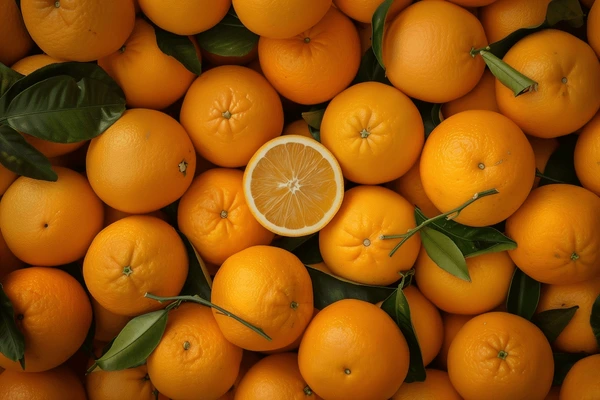The orange is one of the most popular and widely consumed fruits worldwide, known for its vibrant color, refreshing flavor, and abundance of health benefits. Originating in Asia, the orange has become a staple in many households, prized for its juicy and tangy taste, as well as its versatility in both culinary and beverage applications. Oranges are consumed in various forms, from fresh fruit and juice to zest and flavoring in both sweet and savory dishes. They are also an excellent source of vitamin C, an essential nutrient that supports immune health, among other benefits. Whether enjoyed as a snack, in salads, or as fresh juice, oranges offer a refreshing and nutritious addition to any diet.

Origin and History:
The orange is believed to have originated in Southeast Asia, particularly in regions now comprising southern China, Vietnam, and India. Historical records show that oranges were cultivated in ancient China and spread to the Middle East and the Mediterranean region through trade. By the 15th century, oranges were brought to the Americas by Spanish explorers. Over time, the sweet orange (Citrus sinensis) became the dominant variety worldwide due to its sweetness and juiciness, while other types like bitter oranges and blood oranges were also developed.
Varieties:
Oranges come in several varieties, each with its unique flavor, color, and texture:
- Navel Orange: Known for its easy-to-peel skin and sweet, tangy flavor, navel oranges are often eaten fresh or used in salads.
- Valencia Orange: A variety that is famous for juicing, known for its sweet flavor and minimal seeds.
- Blood Orange: Distinct for its deep red flesh and unique, tangy-sweet flavor, which makes it a favorite for culinary and cocktail uses.
- Cara Cara Orange: A type of navel orange with pinkish-red flesh, offering a sweeter and less acidic flavor than regular navel oranges.
- Seville Orange: A bitter orange variety used primarily for marmalade, as well as in some savory dishes.
Nutritional Value (per 100g of raw orange):
- Calories: 47 kcal
- Carbohydrates: 11.8g
- Dietary Fiber: 2.4g
- Sugars: 9.4g
- Protein: 0.9g
- Fat: 0.1g
- Vitamin C: 53.2mg (about 60% of the recommended daily intake)
- Potassium: 181mg
- Folate: 30µg (important for cell function and DNA synthesis)
Health Benefits:
- Rich in Vitamin C: Oranges are an excellent source of vitamin C, a powerful antioxidant that helps support the immune system, protects cells from damage, and promotes the absorption of iron from plant-based foods.
- Boosts Heart Health: The high potassium content in oranges contributes to maintaining healthy blood pressure, while the fiber and antioxidants support overall cardiovascular health by lowering cholesterol levels and improving blood vessel function.
- Supports Skin Health: Vitamin C is crucial for the production of collagen, a protein that helps keep the skin firm and elastic, reducing wrinkles and signs of aging.
- Digestive Health: The dietary fiber in oranges helps regulate bowel movements and prevent constipation. It also supports the growth of beneficial gut bacteria.
- Helps with Hydration: Oranges have a high water content (about 86%), making them a good food choice for hydration, especially in warm climates.
Culinary Uses:
Oranges are incredibly versatile and can be used in both sweet and savory dishes. Some common uses include:
- Fresh Consumption: Oranges are often eaten raw, either peeled or segmented, and added to salads, desserts, or served as a snack.
- Juices and Beverages: Freshly squeezed orange juice is one of the most popular beverages globally, prized for its refreshing taste and high vitamin C content.
- Baking and Desserts: Oranges can be used in cakes, tarts, and muffins, as well as in the form of zest to add a citrusy aroma to dishes.
- Savory Dishes: Orange segments can be added to salads, paired with seafood, or used in sauces and dressings. Orange juice is also a common ingredient in marinades and glazes for meat, particularly chicken and pork.
- Candied Peel and Marmalade: Orange peels can be candied for use in confections, while Seville oranges are traditionally used to make marmalade.
Storage:
Oranges should be stored in a cool, dry place at room temperature if consumed within a few days. For longer storage, they can be kept in the refrigerator to extend their freshness. Orange juice can be refrigerated or frozen for later use, although it is best consumed fresh to retain its maximum vitamin C content. Dried orange peel, often used as a spice or flavoring, can be stored in an airtight container.
Fun Facts:
- The “navel” of the navel orange is a natural formation caused by a secondary fruit growing inside the main fruit, giving it its characteristic shape.
- The largest producers of oranges are Brazil, the United States, and India, with Brazil being the leading exporter of orange juice.
- Orange trees are evergreen, and they can live for up to 100 years, although they typically begin producing fruit after 3 to 5 years.
